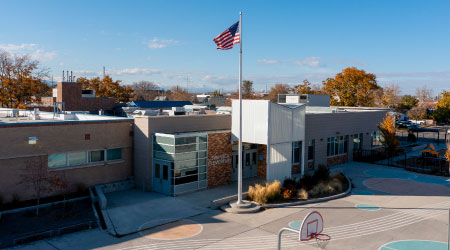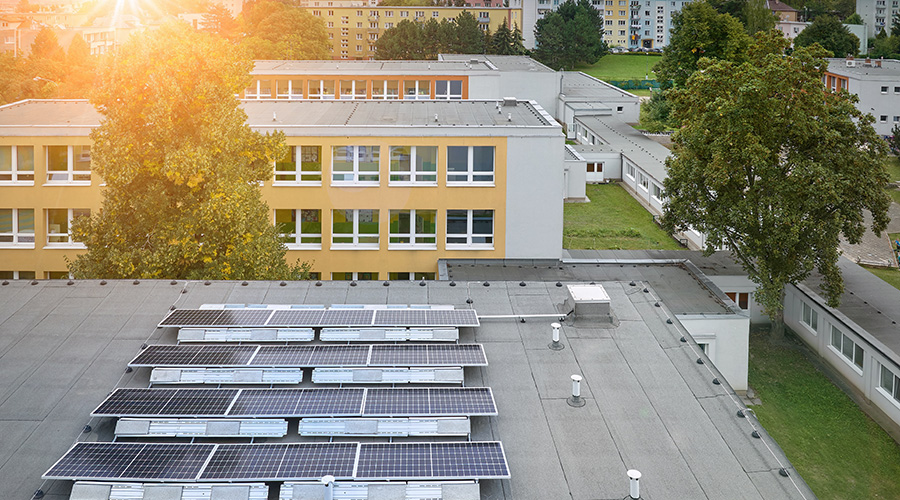Denver Public Schools Embraces Net-Zero Plan
Denver Public Schools responds to students’ demands with long-term net-zero plan.
Younger generations are raising their voices about climate change. They want action from their leaders, and they want it now.
Leaders in Denver Public Schools (DPS) learned this three years ago during the pandemic, when about 30 students from eight different schools gathered for a Board of Education meeting to express their concerns.
The students’ efforts were rewarded. After meeting with elected officials and community members, starting their own website to inform the public and also knocking on doors to receive more than 4,000 signatures to earn support, the district adopted a climate plan in April 2022.
“Our futures depend on us taking action,” one of the DPS students wrote on the website.
The plan sets the district on a path to reduce overall greenhouse gas emissions by at least 90 percent by 2050, based on the levels of district-wide emissions levels that existed in 2010. Targeting old buildings with retrofits and constructing new buildings with net-zero emissions in mind is playing a major role in achieving those goals.
While 2050 seems a lifetime away — and the challenge to achieve net-zero can feel daunting — DPS is attacking the goal in shorter, more achievable steps along the way while educating district leaders on the best steps to get there.
Starting the process
Achieving net-zero goals can be challenging in any setting, but especially so in a large school district consisting of about 200 buildings serving 90,000 students and 15,000 employees.
However, DPS is well on its way. The district has been practicing sustainability measures since 2009 and has already equipped 46 buildings with solar arrays, planning to fit four schools with solar shades and is installing its first solar canopy in a school parking lot as part of a community solar program that includes the city and county of Denver. The array is one of 11 across the county with a portion of the produced energy going to DPS families to help offset utility bills.
In addition to the solar advances, the district has already retrofitted its facilities with LED lighting and established 122 community gardens.
“The city and county of Denver is super involved,” says LeeAnn Kittle, the district’s director of sustainability who came on board three years ago during the COVID-19 pandemic. “They’ve given us grant dollars and other forms of funding. We have a very unique relationship with the city and county. They have a 0.25 percent sales tax that’s created specifically for climate action, and so schools certainly fit within a lot of how their money is allowed to be spent. Plus, we’re the largest footprint outside the city itself, square footage wise, so they have a reason to work with us and we have a reason to work with them. It’s symbiotic.”
Several of the aforementioned projects, such as the solar shades project, came courtesy of grant money. In a financial atmosphere when public funding for schools can be a challenge, DPS also relies heavily on bond reserve dollars and a $31.4 million energy performance contract that is the second largest in state history.
In efforts to ensure the district can find every dollar it can for projects, Kittle brought a contracted grant writer on staff to keep an eye out for every funding avenue possible.
“I think that’s part of my role is to make sure that all funding sources are looked at,” she says. “So, I personally look at that, and I definitely have people who send me stuff, but I would say between myself and our contracted grant writer we keep our hands on the pulse.”
While the public and school and government officials are generally supportive of DPS’ efforts to achieve carbon neutrality, Kittle has found that proper messaging always helps. While facility managers and the climate change experts are familiar with terms such as net-zero, selling the public and officials is a bit more difficult task.
“I would say we don’t utilize net-zero because of that, because it is somewhat confusing to those that aren’t actually in the field,” she says. “We find that carbon emission reduction or greenhouse gas emission reduction tends to land in terms of language people understand.
“It is about understanding the language of the people in which you are speaking to. When we are talking to our CFO, we are talking about net present cost, first cost, investments. When we’re talking to our chief operating officer, we’re talking about energy consumption.”
Dave Lubach is the executive editor of the facility market. He has more than eight years of experience reporting on facility management and maintenance issues.
Related Topics:













